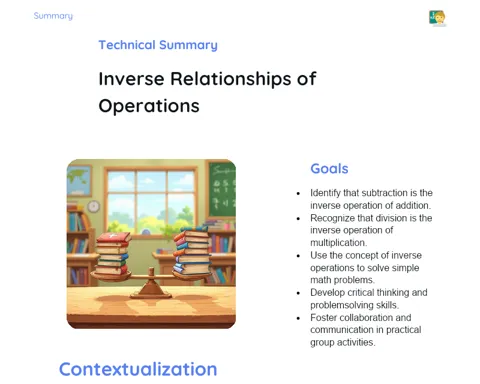FUNCTION TOPICS: INPUTS AND OUTPUTS
KEYWORDS
- Mathematical Function
- Domain
- Codomain
- Image
- Input (x)
- Output (f(x))
- Mapping
- Dependency Relation
KEY QUESTIONS
- What determines a mathematical function?
- How to identify the domain and codomain of a function?
- How does the input (x) affect the output (f(x)) in a function?
- What kind of relationship exists between input and output within a function?
CRUCIAL TOPICS
- Understanding the concept of a function as a special relationship between two sets.
- Identification and interpretation of ordered pairs (input, output).
- Differentiation between domain (set of possible inputs) and codomain (set of possible outputs).
- The image of the function is the set of all outputs produced by the inputs in the domain.
SPECIFICITIES BY KNOWLEDGE AREAS
FORMULAS
- Function definition: f: X → Y | for every x in X, there exists a unique y in Y such that f(x) = y
- Function notation: f(x) represents the output of function f for an input x.
- Example of linear function: f(x) = mx + b, where m is the slope and b is the y-intercept.
- Example of quadratic function: f(x) = ax² + bx + c, where a, b, and c are constants and a ≠ 0.
DETAILED NOTES ON FUNCTION: INPUTS AND OUTPUTS
Key Terms
- Mathematical Function: Relationship between two sets that associates each element of the first set with exactly one element of the second set.
- Domain: Set of all possible inputs (values of x) for which the function is defined.
- Codomain: Set of values that the function output (values of f(x)) can take.
- Image: Subset of the codomain that is actually reached by the function values.
- Input (x): Value inserted into the function, which is transformed to produce an output.
- Output (f(x)): Result obtained after applying the function to the input.
- Mapping: Process of associating elements of the domain with elements of the codomain.
- Dependency Relation: Indicates that the output value depends exclusively on the input value.
Main Information and Concepts
- Functions as Machines: Visualizing functions as 'machines' where we input an 'x' (input), and it gives us an 'f(x)' (output) helps in understanding the processing of functions.
- Unique Relation: In a function, each input corresponds to one and only one output, never multiple outputs.
- Domain and Image: Understanding that not necessarily all values of the codomain are reached by the function is fundamental; the image is what is actually reached.
Topic Contents
- Function Notation: Learning to read and write expressions like f(x) = 2x + 3, understanding that 'f' is the function name, 'x' is the input variable, and '2x + 3' is the rule that determines the output.
- Evaluating Functions: Knowing how to substitute values in place of 'x' and calculate the result is crucial to find function outputs, for example: for f(x) = x², if x = 3, then f(3) = 3² = 9.
- Graph Analysis: Understanding function graphs allows visualizing how the input affects the output, facilitating the understanding of the function's behavior.
Examples and Cases
- Linear Function: f(x) = 2x + 1. For input x = 5, the output is f(5) = 2(5) + 1 = 11.
- Shows a direct and constant relationship where the graph would be a straight line.
- Quadratic Function: f(x) = x² - 4x + 4. For input x = 2, the output is f(2) = 2² - 4(2) + 4 = 0.
- Illustrates a relationship where outputs vary non-linearly in relation to inputs.
- Interpreting Graphs: Given the graph of f(x) = x², identify that as x increases, the output f(x) grows squared.
- Reinforces the visual understanding of the relationship between input and output.
SUMMARY
Summary of the most relevant points
- Functions: Relationships that map each input (x) to a single output (f(x)).
- Domain: Set of all possible inputs for the function.
- Codomain: Set of all outputs that the function can produce.
- Image: Set of outputs that are effectively reached by the function.
- Function Notation: The form f(x) represents the function output for the input x.
- Function Behavior: The relationship between x and f(x) can be direct, inverse, linear, quadratic, etc.
Conclusions
- Each input in a function has a unique corresponding output, with no duplicity.
- Understanding the notation and the rule that defines the function is essential to calculate its output.
- The ability to evaluate functions is built through the practice of substituting inputs and calculating outputs.
- Analyzing graphs helps visualize and understand how inputs affect outputs.
- Applying functions to practical problems develops logical reasoning and data interpretation skills.



